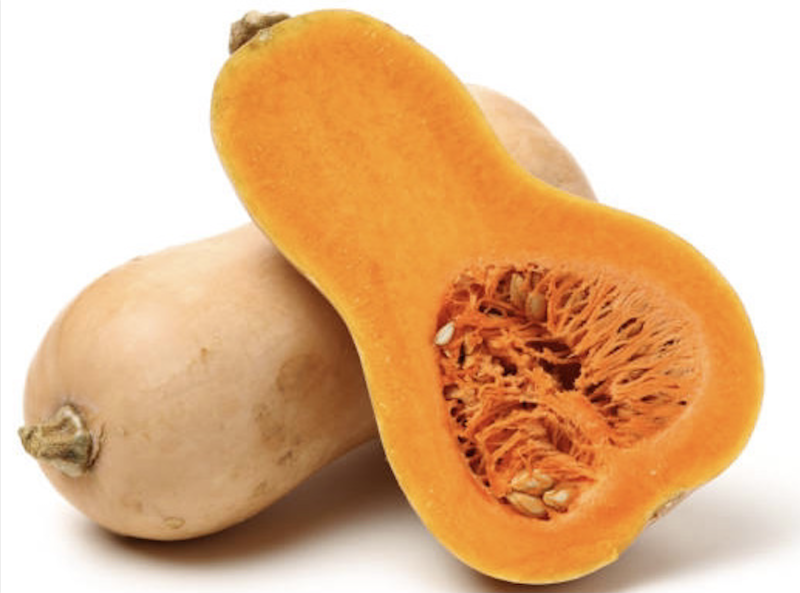Winter squash can accent the menu as fall begins
As I mentioned last week, it’s the perfect time of year to talk about winter squash, which are appearing in colorful displays at every farm stand, supermarket and specialty grocery. Winter squash are in the genus Curcurbita, the Latin word for “gourd,” and are considered a fruit from a botanical perspective, but often referred to as vegetables. Common varieties include butternut, delicata, Hubbard, kabocha, spaghetti and acorn. The many sizes and shapes of what we call pumpkins are probably the most familiar example of winter squash.
They’re harvested once the colors of their outer skin have deepened, their seeds have matured and their skins have thickened. Their seasonal name comes from their storage hardiness through the winter, because of the hard rind and sweet, dense flesh that can last up to a year after harvest. The bright-orange color of the flesh signals these are nutritional gems, loaded with beta-carotene, an important antioxidant. These tasty vegetables are 90% water, fat-free, low in carbohydrates and high in fiber.
They originate from South America and according to food historians have been cultivated for over 10,000 years. Native Americans featured winter squash as an important element of their diet, and they were a valuable sustenance crop for European settlers. While they grow in a range of soil conditions, they require full sun and are notorious for being a space-intensive crop with sprawling vines. Planted in the spring, they should be harvested before the first frost.
Considered culinary chameleons, winter squash can be the key ingredient in a range of both sweet and savory dishes. I’ve stirred puréed squash into chili, tomato sauce and stews to add subtle sweetness and just a bit of thickening. We’ve had muffins, soups, quick breads and salads all featuring winter squash as the base ingredient. There are two ways to cook winter squash: Roast it whole or halved, or dice the flesh and steam, bake or sauté the pieces. Don’t forget to toast the seeds, a delicious topping for soups and salads.
The first order of business when dealing with a heavy, hard-skinned squash is to get past the exterior rind with the sharpest knife in your kitchen. The photo shows a butternut squash halved lengthwise to expose the seed bundle in the lower center cavity. Scoop these out, remove the strings and spread the seeds on a baking sheet, then roast until crisp and golden. An easy way to roast the flesh and avoid additional knife work is to place the halves in a pan and bake until tender.
Once the squash has been cooked, you can remove the softened flesh and use it for the base of a creamy soup or add it to oatmeal, as in the recipe below. If you want chunks to toss on a salad, you’ll need to chop the raw flesh into cubes, toss them with olive oil, and roast them until softened. I’ve given the specific process to roast squash, along with a mac and cheese recipe that includes the creamy purée to add some healthy flavor to a family favorite.
Butternut Squash Purée*
Preheat oven to 400 F. Wash and pat dry the squash. With a sharp knife, trim off the ends and cut in half lengthwise. Remove the seeds and strings. Brush flesh with olive oil; sprinkle with kosher salt. Place the squash halves cut-side down on a rimmed baking sheet. Bake until tender, about 45 to 60 minutes. Allow to cool enough to handle. With a spoon, scoop out the flesh and place it in a food processor or blender. Purée until smooth.
Butternut Squash Oatmeal
Combine oats, milk, butter, cinnamon and nutmeg in a small saucepan over medium heat. When the mixture begins to bubble, mash in banana and squash. Reduce heat to low and cook until oats have softened and mixture has thickened. Serve warm. Yield: 1 serving.
Butternut Squash Mac & Cheese*
16 oz dry pasta (elbow or penne)
4 T butter
1 minced shallot
2 minced garlic cloves
8 chopped sage leaves
3 T flour
1 C vegetable broth
1 1/2 C half & half
salt & pepper, to taste
1/8 t nutmeg
1 1/2 C butternut squash purée
1 C grated Parmesan cheese
1 1/4 C shredded extra-sharp cheddar cheese, divided
Cook the pasta according to the package directions for al dente. Coat the inside of a 9-by-12-inch casserole dish with nonstick cooking spray; set aside. Melt butter in a large saucepan over medium heat. Add shallot and garlic; sauté until soft, about 2 to 3 minutes. Stir in sage; cook for 1 minute. Whisk in the flour; cook for 1 to 2 minutes. Whisk in the chicken broth, stirring until smooth. Add half & half, stirring until combined. Add salt, pepper and nutmeg. Cook over medium-low heat until mixture has thickened, about 4 to 5 minutes. Reduce heat to low; stir in butternut squash purée, Parmesan cheese and 1 C of the cheddar cheese. Once pasta is cooked, drain and stir into the cheese sauce. Preheat the broiler to high. Transfer mixture to prepared pan; sprinkle with remaining cheddar cheese. Place pan under the broiler until the cheese is melted and light golden brown in spots, about 3 to 4 minutes. *Adapted from the Saratoga Farmers Market.























































